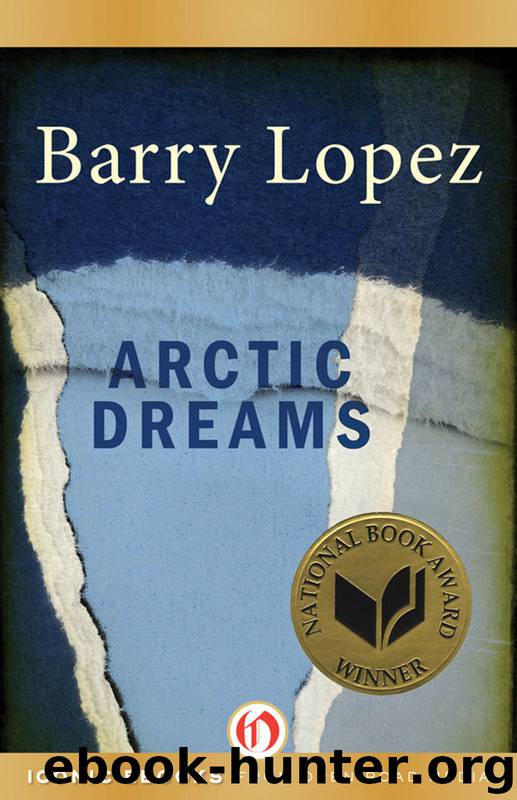Arctic Dreams by Barry Lopez

Author:Barry Lopez [Lopez, Barry]
Language: eng
Format: epub, mobi, azw3
Tags: Ecology, Ecosystems & Habitats, Polar Regions, Nature
ISBN: 9781480409149
Publisher: Open Road Media
Published: 1986-01-01T05:00:00+00:00
Areas of year-round open water in the Canadian Arctic. Adapted from Ian Stirling and Holly Cleator, Polynyas in the Canadian Arctic.
One cannot consider polynyas, of course, without recalling images of narwhals and belukhas fatally trapped in savssats; and the precipitate oscillations in normal sea-ice formation that can catch tens of thousands of early-arriving or molting seabirds by surprise. (In the spring of 1964, 100,000 king eiders—one-tenth of the regional population—were frozen-in in the Beaufort Sea.) A very real sense of loss in the face of large-scale catastrophe, however, can obscure how integral to the nature of northern ecosystems this edge between life and death is, an edge the annual formation of sea ice sharply accentuates.
One fall afternoon a friend, an ornithologist, was counting migrating birds near Demarcation Bay on the north coast of Alaska, at a place called Pingokralik. On several tundra ponds he was also following the progress of three or four families of red-throated and arctic loons. Loons are unable to walk on land, and they require plenty of open water for taking off. Early in September, when the red-throated loon chicks were barely half their parents’ size, the coast was buffeted by snow squalls. Within a few days the tundra ponds were frozen over. My friend emerged from his tent one morning to find a red-throated loon and its chick paddling about energetically in an effort to maintain a small patch of open water. The other parent, which had spent the night at sea, flew by every half hour or so with food in its beak, but it could no more land than the other bird could take off.
The next day it warmed up enough so the pondbound adult could take off and the other bird could land with food for the chick. The loons—there were other families in similar straits nearby—persevered in this manner, even as the human observer was driven off to a more permanent shelter. He did not know the fate of the loon chicks (the adults may well have abandoned them). What he remembers seeing were the adults flying back and forth strongly from the sea, dark spots fading in the snow squalls. Resolute, even in the face of poor timing. Successful animals.
During parts of one summer I lived at the Canadian government’s Polar Continental Shelf camp at Resolute, Cornwallis Island, a staging area for scientific research in the Arctic. During those weeks I was able to speak with a number of scientists—archaeologists, biologists, geologists, ornithologists; but one of my strongest memories is of an evening I spent with a retired geologist named Maurice Haycock, talking about painting. Haycock was in his eighties when I met him. He had had a long and successful career as a geologist with the Canadian government and had played the French horn for many years in the Ottawa Symphony Orchestra. He had also traveled occasionally with the Canadian landscape painter A.Y. Jackson, both of them painting in the Northwest Territories on geological field trips.
One afternoon Haycock and
Download
Arctic Dreams by Barry Lopez.mobi
Arctic Dreams by Barry Lopez.azw3
This site does not store any files on its server. We only index and link to content provided by other sites. Please contact the content providers to delete copyright contents if any and email us, we'll remove relevant links or contents immediately.
Welcome to the Goddamn Ice Cube by Blair Braverman(1601)
Iced In by Chris Turney(1579)
Arctic Dreams by Barry Lopez(1415)
The White Darkness by David Grann(1321)
Mawson's Will by Lennard Bickel(1146)
Big Dead Place: Inside the Strange and Menacing World of Antarctica (Large Print 16pt) by Nicholas Johnson(1116)
Caroline Alexander by The Endurance: Shackleton's Legendary Antarctic Expedition(1099)
The Stowaway by Laurie Gwen Shapiro(1031)
Mummies and Pyramids by Mary Pope Osborne(980)
South Pole by Elizabeth Leane(979)
Tip of the Iceberg by Mark Adams(976)
Bound by Ice by Sandra Neil Wallace(965)
In the Kingdom of Ice by Hampton Sides(964)
Ice! by Tristan Jones(963)
Home by Beth Powning(925)
The Ice Balloon: S. A. Andree and the Heroic Age of Arctic Exploration by Wilkinson Alec(900)
Ice Diaries by Jean McNeil(864)
The Snow Walker by Farley Mowat(837)
Future Arctic by Edward Struzik(817)
